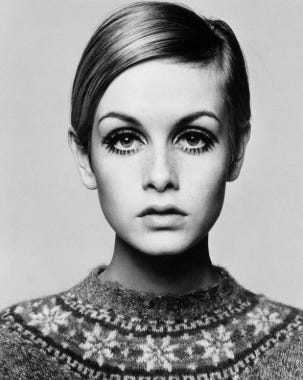Reservations is part of a series in which I am having a conversation with history through a cast of characters symbolic of larger issues faced by women in this culture. I am using resource photographs from Library of Congress taken in the late fifties and early 1960’s by Angelo Ruizzoto. The resource photograph for this composition was titled Woman with the Feather Hat. It was her outfit that drew my attention at first glance.
The women with her head resting on her her hand was certainly stylish and not dressed for an office. Even though the photograph was in black and white, I am fairly certain her animal print dress and hat were in neutral brown tones. It was the era where animal prints were a major fashion trend. The prints were seen as a symbol of glamour and sophistication.
The animal print trend may have started after Maureen O’Sullivan’s character Jane in the 1932 hit movie “Tarzan”. Women loved the adventurous Jane and her animal skin attire. A decade later Dior created a very popular leopard print for his 1947 New Look Collection. He advised women: “If you are fair and sweet, don’t wear it.” The look was for the exotic woman only.
In the 1950’s the average dress size was 12. Over decades the average dress size has increased. According to a study from the International Journal of Fashion Design, Technology and Education the average is between 16 and 18. Ten years ago this average size was 14.
Standards of beauty change over time. Each decade seems to have a trend in the world of fashion. Twiggy was the face of fashion in the late sixties. She was arguably the first supermodel. She was just 5’6” and her weight was 92 pounds. It was her hairstyle and almost looking like a boy that captured the public attention.
The 1980’s featured super models like Cindy Crawford and Beverly Johnson. They and others were made famous as models by the Ford Agency who seemingly determined beauty for a decade. These models were slim and very tall but not unhealthy looking.
“Heroin Chic” dominated the 90’s. It was a reaction to previous decade of the perfect girl. Models mimicked the look of addicts on the runway. Pale skin, dark circles underneath the eyes, emaciated features, androgyny and stringy hair were featured in major ad campaigns including Kate Moss for Calvin Klein.
Today models go beyond a single agency or look. Venezuelan-born América Gonzál and Chinese born Yilan Hua embrace the diversity global cultures. Size is not as limiting as it used to be. Jill Kortleve may be most well-known for being a "plus"-size model walking the Chanel runway at fashion week.
In art there are examples of an iconic female form. One is Le Déjeuner sur l'herbe, or Lunch on the Grass by Edouard Manet. It is a work that one studies in every college introduction to art history class. It depicts a nude woman and barely dressed bather in the distance having a picnic with two fully dressed men. The painting was made famous after being rejected by the Paris Salon.
Lunch on the Grass is monumental in size measuring 81” x 104”. The subject matter was shocking to the judges no doubt because it implies sexual misconduct. College textbooks often mention how the artist was “reinterpreting paintings” by the old masters for a modern audience. Manet’s claimed to have been inspired when he and the writer Proust spotted a woman bathing in the Seine.
Whatever the inspiration, I look at this painting as reeking of misogyny. Monet, Cezanne, and even Picasso have used Manet’s Luncheon on the Grass as inspiration for new work without duplicating the all too obvious quality of men seeing a woman as a sexual object. A few critics have said that Manet was representing female sexual energy suggesting that Manet was painting from a feminist perspective. I would disagree.
A painting by contemporary African American painter Mickalene Thomas directly challenges Manet. It includes three clothed female figures looking directly at the viewers with a clear message of taking back their power. An article the The Collector states:
These women will not be exploited and they will not make apologies. Here, women have gone from the “viewed” to the viewer.
I don’t remember my mother or her friends spending time on controlling their weight or being super fit or for that matter being perfect. They seemed more interested in style like the women in the feather hat whose outfit sent a message. It was the era of dressing for properly for lunch, cocktails, or church. By the mid 1960’s the counterculture movement reacted boldly to that formality.
The notion of wearing jeans, tie dyed t-shirts, and sandals annoyed those who bought into a culture where fashion sent a message of propriety. The hippies seemed dangerously rebellious to traditional Americans. Eventually the pendulum of swung the other way. The hippie style was replaced 1980’s with a style that embraced power and class structures.
In the day women dressed in power suits with big shoulder pads. Form-fitting spandex, bold color, sequins, and very sexy looks dominated evening trips to a disco. On the weekend Izod shirts with turned up collars, burmuda shorts and docksiders were in style mimicing a prep school look.
Today it seems beauty and fashion is determined by the forces of social media. With influencers becoming the arbiters of beauty for their following. It’s a complex and sometimes toxic mix especially for adolescents.
“Reservations” is more than a portrait of style. It’s about the reservations I have with the current culture and its impact on my children and grandchildren. The implications of so many things including social media, the emphasis on external beauty, wealth, power, and the disregard for those who don’t fit neatly into the current cultural fashion.
Until Next Time…
Margaret










Great recap and full of insight. Thanks!